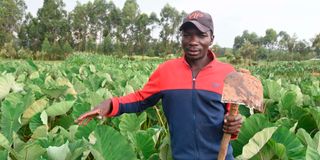Farmer Ramadhan Mutenyo: I don’t rue switching from cane to nduma

Ramadhan Mutenya at his arrow roots farm in Matungu, Kakamega county.
As many people turn to eating healthy indigenous food, arrowroot (nduma) is becoming more and more popular.
The tuber, which can be boiled or roasted, is the preferred breakfast meal in many hotels and homes.
The arrowroot was once considered a water crop as it was normally grown near rivers or swamps.
With agriculture research growing by the day, some new hybrid arrowroot varieties can be grown in areas with little water.
In Busombi village of Matungu constituency, farmers have built a clientele base that delivers arrowroot to most parts of Kakamega county.
Kakamega, Busia and Bungoma have traditionally been known to produce sugarcane since the early 1970s. With the collapse of sugar millers, farmers diversified into other enterprises.
Ramadhan Mutenyo, 32, is among locals who abandoned sugarcane in favour of arrowroots in 2016.
“When I compared proceeds from sugarcane with the promises I got from my neighbour who introduced me to nduma, I quickly switched crops. Arrowroot farming pays,” he says.
Mr Mutenyo started growing arrowroots on half-acre piece but has expanded the venture to an acre and a half.
“I make three times the amount I could get from two-acres of cane. School fees arrears are a thing of the past. I have also bought several dairy cows, courtesy of the arrowroots,” he says.
When the Seeds of Gold team caught up Mutenyo at his farm around 4pm, he was busy weeding.
The farm is near the road connecting Kandai and Busombi villages in Khalaba sub-location.
Mutenyo has adopted the succession planting method where arrowroots are planted at different periods. This ensures the plants are in different stages at any given time. Harvesting is spread throughout the year.
“When the mature arrowroots are harvested, another cycle should be ready. The sequence goes on for continuous supply of arrowroots. Growing nduma has been my only occupation for years,” he says.
Mutenyo harvests at least 100 kilos of nduma every week. The yield is sold to traders from Nairobi and other major Kenyan towns.
Middlemen sell a 70kg sack of nduma to traders in Nairobi at Sh10,000 but buy from local farmers at Sh6,500.
Kakamega County Chief Agriculture Officer Hillary Onjoro says arrowroots take five to six months to mature.
“Two varieties are commonly grown in Kakamega – Dasheen and Eddoe. Dasheen has large tubers and does well in lowlands while Eddoe, which has smaller tubers, can blossom in areas with little water,” Onjoro said.
The official advises farmers to grow yams in open areas because shade reduces yields.
“The crop can be planted in trenches or holes. Those in holes mature faster. But planting in trenches allows harnessing of water,” Onjoro said.
Arrowroots are planted from suckers in holes that are a foot deep. The holes should be a foot and a half from one another.
“This allows the plants to have adequate space to grow big,” Onjoro added .
Farmers apply manure or fertiliser after two weeks. Weeding must be constant as this ensures the farm is clean. Mulching prevents moisture loss but the land should not be waterlogged.
Mutenyo and Onjoro say waterlogging can lead to the rotting of tubers.
Nduma has many health benefits, including regulation of the heartbeat and blood pressure, aiding in digestion, boosting immunity and clearing excess cholestrol from the body.





